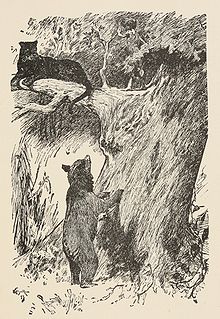The Jungle Book. By Rudyard Kipling. Illustrated by Kurt Wiese and William Henry Drake. Everyman's Library, 1894. 216 pages.
Ask most people if they've read The Jungle Book, and you'll get the same answer: "No, but I've seen the movie." Well if that's you, prepare yourself for something completely different: this is definitely not Disney! Rudyard Kipling's classic tale is filled with darkness. Death is a constant presence, lurking in the shadows waiting for a chance to pounce. In Kipling's version, the jungle-dwellers know that any moment of weakness can bring about their own violent downfall, and even the strongest of them understand that the time will come when age and weakness will leave them vulnerable, perhaps even to their own pack.
This is the world into which the young "Man-cub" Mowgli is thrust after his parents are forced to abandon him as they flee from the man-eating tiger, Shere Khan. Mowgli is discovered by Mother and Father Wolf, who decide to to keep Mowgli and raise him as their own. According to the Law of the Jungle, they must introduce the child to the wolf pack and ask approval to keep him. While the wolves ultimately agree to let young Mowgli remain with them, Shere Khan insists that the boy is his by rights, and swears that he will one day kill him. Mother Wolf, on the other hand, claims it is Mowgli's destiny to grow up and kill Shere Khan.
 | |
|
Mowgli and his adopted family know that one day he will have to return to the world of men, but before that time comes Mowgli will have many adventures and meet up with every type of animal, from the Bandar-log (monkey people) who know no law, to the conniving jackal Tabaqui. Mowgli learns the ways of the jungle, and is able to communicate with all of the animals. He gets into and out of danger, often calling on the creatures for help. In the end, Mowgli has to decide which destiny to pursue: destroy Shere Khan, or take his place in the world of men.
 |
| Illustration from The Jungle Book (1894) |
Interwoven into these tales are the equally enjoyable but unrelated stories of The White Seal and Rikk-Tikki-Tavi, the cobra-killing mongoose (among others). Masterpieces of children's literature and triumphant feats of imagination, these stories have held the attention of young and old alike for more than a century. Give them a try and you'll come to learn what good readers already know: the book is always better!
 |
| Rikki-Tikki-Tavi. Illustration from The Jungle Book (1894) |














